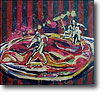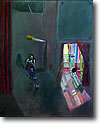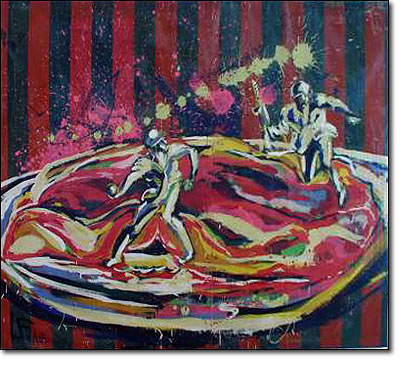Fundacion Proa ,
Nov 01, 2003 - Feb 04, 2004
Buenos Aires , Argentina
Argentine art in Proa
by Viviana Usubiaga
This complex historical trauma overshadowed the rest of the exhibition, which mixed together theatrical programs, record covers, posters, wardrobes, press cuttings, puppets and paintings of the culture emerging after the forced abstinence of expression. It was the history of the survivors, of the first generation of artists who maximized on the possibilities offered to them by the freedom finally attained. They took over the public spaces, those previously covered in darkness and places which had been restricted. They made use of all the surface areas for their painting, from the street itself to the doors of a placard for the self-referential supplications of Alfredo Prior. Corrugated cardboard as in the work of Carlos Masoch, and large papers for fashioning works in collaboration - with joined at random Kuitca with Prior or Cambre and Monzo and Rearte, among others- were as much used as materials and screens for unending individual production at their private workshops. The utilization of precarious supports to attain the most varied dimensions accompanied the explosion of painting, in accord with its new international popularity. They exhausted the possibilities of the materials they encountered in their path. This was done by Luis Frangella with a canvas painted at the café Einstein in 1984, where he recorded the violence at the hand of two military officers. This was the interpretation accorded by the Loc-son group, formed by Okner, Bueno and Conte, when they painted "Niños danzando" (1983), with wall paint on polyethylene, showing the figure of Luca Prodan, singer with the Zumo group and emblem of national rock at that moment in time.
In those years the expansion of space occurred in two dimensions. On the one hand, there was an overloading of the foreground in the pictorial representation itself, where everything occurred without a defined spatial composition. On the other, in the extension of the places for production and exhibition within public circuits. Although painting had never been abandoned - despite the announcement of its death decades before - its methods of production were transformed, acquiring collective, compulsive and performatic forms which made use of "poor" materials. The private space of the workshop was amplified on the stage of alternative theater, painting was part of the performance; the platforms of the subterranean railway as an exhibition hall. At the same time the dramatic space was assimilated within the painting, as in the scenes of Kuitca, where the actors were protagonists of the work. The portrait of Batato Barea, star actor of the underground circuit, by Marcia Schvartz is a key piece of the exhibition and an icon of the decade. Barea, surrounded by his household effects and with a background of flowers, flourishes a weapon, the prelude to Death. Parody as an antidote to tragedy intoxicated the epilogue of horror. After censorship and human disappearances, there was a need for activating work and taking the body as a theme, making the latter visible even to evidence absence or for transformation into monstrous anthropomorphous animals, as in Ana Eckell’s paintings.
The exhibition, which concentrated on the fine arts weaving links to other aesthetic productions (in some cases with lukewarm results, as in the music section which was the unharmonious finale of the exhibition), was a suitable occasion to reflect on the readings and non-readings made on an artistic production which had remained at the "rear" of art historical studies. The visibility of Argentine art in the 80s was almost circumscribed to the same decade which witnessed, first, its enthusiastic flowering, and then its submergence into the negative balance of other political and social phenomena.
There is no doubt that some Argentine works of the 80s were influenced by German neo-expressionism, or flirted, for example, with the Italian Transvanguardia promoted during the various visits of its mentor, Achille Bonito Oliva, to Argentina from 1981 onwards. The worldwide influence of the Italian critic’s aesthetic program is undeniable, but insufficient to explain the complexity of the local phenomenon. This appears to be how it was understood by Adriana Rosenberg, President of the Fundación Proa, on programming the exhibition on the vernacular panorama of the 80s following the exhibition La Transvanguardia italiana. Chia, Clemente, Cucchi, De María, Paladino, whose curator was Bonito Oliva himself. From this perspective, this exhibition can be interpreted as an invitation to re-think one’s memory and beliefs which surpasses written history based on an interpretation of international aesthetic currents as adapted to the local environment, and revealing the roots of the past in order to write a new history of recent Argentine art.
|













